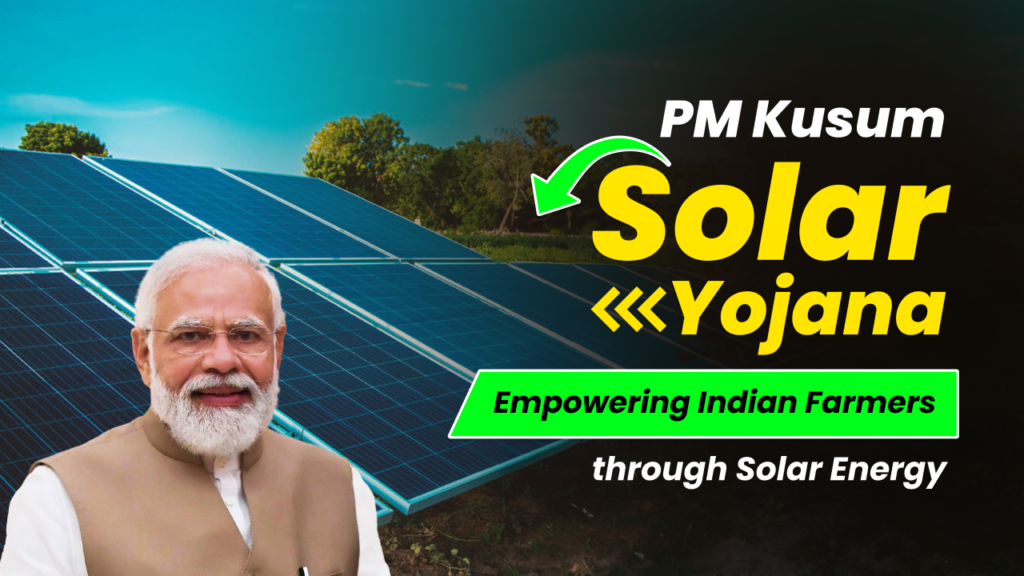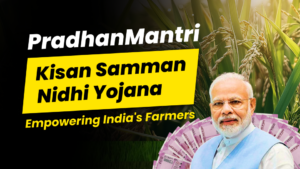
The PM Kusum Solar Yojana, officially known as the Pradhan Mantri Kisan Urja Suraksha Evam Utthaan Mahabhiyan, is a landmark initiative launched by the Government of India to enhance the income of farmers while promoting sustainable energy. This ambitious scheme aims to provide solar energy solutions to farmers for irrigation and other agricultural activities, reducing their dependency on conventional sources of power. As part of the government’s broader strategy to double farmers’ income by 2022, the PM Kusum Yojana plays a critical role in transforming the agricultural sector through renewable energy.
Latest News about PM Kusum Scheme
The PM Kusum Scheme has recently seen several significant updates. The Ministry of New and Renewable Energy (MNRE) has announced the extension of the scheme until 2024 with additional funding and increased subsidies for solar pump installations. This extension is designed to accelerate the deployment of solar pumps and grid-connected solar power projects across the country. Moreover, the government has introduced online portals for easier registration and application processes, enhancing accessibility for farmers.
The objective of the Scheme
The primary objective of the PM Kusum Yojana is to promote solar energy generation and ensure energy security for farmers. The scheme aims to:
- Reduce farmers’ dependency on diesel and electric-powered irrigation systems.
- Provide reliable daytime power for irrigation and other agricultural activities.
- Enhance farmers’ income by allowing them to sell surplus solar power to the grid.
- Promote the use of renewable energy in agriculture, contributing to environmental sustainability.
- Facilitate the government’s goal of achieving 100 GW of solar power capacity by 2022.
Eligibility Criteria
For Borrowers
Farmers, cooperatives, panchayats, and water user associations are eligible to apply for the PM Kusum Yojana. Applicants must own cultivable land and have access to a reliable water source for irrigation.
For Projects
Eligible projects under the PM Kusum Scheme include the installation of standalone solar pumps, solarization of existing grid-connected pumps, and setting up of grid-connected solar power plants. Detailed project eligibility criteria can be found on the PM Kusum Solar Yojana Official Website
Details of the Scheme
Types of Facilities
The PM Kusum Yojana is divided into three components:
- Component-A: Setting up of 10,000 MW of decentralized ground/stilt-mounted grid-connected solar power plants.
- Component-B: Installation of 20 lakh standalone solar-powered agricultural pumps.
- Component-C: Solarization of 15 lakh grid-connected agricultural pumps.
Loan Quantum
The quantum of loan provided under the scheme varies based on the project and the borrower’s creditworthiness. Generally, loans cover up to 80% of the total project cost.
How Much Beneficiaries Are Required to Contribute?
Beneficiaries are required to contribute 10% of the project cost, with a 30% subsidy provided by the government. The remaining 60% can be availed through loans from financial institutions.
Disbursement Mode
Loans are disbursed in phases, ensuring that funds are utilized effectively for project completion. Disbursements are linked to project milestones and compliance with specified guidelines.
Interest Rate
The interest rates for loans under the PM Kusum Scheme are competitive and vary based on the lending institution and the borrower’s credit profile. Typically, rates are lower than standard agricultural loans due to the subsidized nature of the scheme.
Security and Security Documents
Adequate security, such as a mortgage of land or hypothecation of assets, is required to secure the loan. Detailed documentation and compliance with lending norms are mandatory.
What is the Repayment Period?
The repayment period for loans under the PM Kusum Yojana extends up to 10 years, with a moratorium period of up to 12 months, providing sufficient time for project completion and income stabilization.
Relation with Union Agri. Infrastructure Loan Scheme (UAILS)
The PM Kusum Yojana is designed to converge with the Union Agri. Infrastructure Loan Scheme (UAILS), offering additional benefits and streamlined processes for eligible projects.
Insurance and Risk Management
Projects under the PM Kusum Scheme are eligible for insurance coverage to protect against unforeseen risks and damages, ensuring financial security for farmers.
Due Diligence
Thorough due diligence is conducted by lending institutions to evaluate project feasibility, borrower credibility, and compliance with scheme guidelines.
Additional Terms and Conditions
Additional terms and conditions apply as per the specific requirements of the project and lending institution. These include adherence to environmental norms, compliance with local regulations, and timely submission of progress reports.
Key Implementation Guidelines of the Scheme
- Projects must adhere to technical standards specified by the MNRE.
- Beneficiaries must complete registration and application processes through authorized portals.
- Regular monitoring and reporting are required to ensure project compliance and timely disbursement of funds.
- Collaboration with state governments and local authorities is essential for successful implementation.
Benefits of PM Kusum Solar Scheme
The PM Kusum Yojana offers numerous benefits to farmers and the agricultural sector:
- Cost Savings: Significant reduction in irrigation costs by replacing diesel and electric pumps with solar-powered pumps.
- Income Generation: Opportunity to sell surplus solar power to the grid, generating additional income for farmers.
- Sustainability: Promotion of renewable energy reduces carbon footprint and supports environmental sustainability.
- Energy Security: Reliable day-time power supply for irrigation, enhancing agricultural productivity.
- Government Support: Attractive subsidies and financial assistance reduce the financial burden on farmers.
Limitations of the PM Kusum Scheme
Despite its numerous advantages, the PM Kusum Yojana faces certain challenges:
- High Initial Cost: The initial investment for solar pump installations can be high, even with subsidies.
- Awareness and Accessibility: Limited awareness and accessibility in remote areas may hinder scheme adoption.
- Maintenance: Regular maintenance of solar equipment is essential for optimal performance, which can be a challenge for some farmers.
- Grid Connectivity: Ensuring reliable grid connectivity for selling surplus power can be difficult in some regions.
Government’s Vision with PM Kusum Solar Yojana
The government’s vision with the PM Kusum Yojana is to transform the agricultural sector by integrating sustainable energy solutions. By promoting solar energy, the scheme aims to enhance farmers’ income, reduce dependency on fossil fuels, and contribute to India’s renewable energy targets. The PM Kusum Yojana is a testament to the government’s commitment to a greener, more prosperous future for Indian farmers.
FAQs
Farmers can apply for the PM Kusum Yojana through the official MNRE portal or authorized state portals. Detailed guidelines and application forms are available online.
The government provides a 30% subsidy on the total project cost under the PM Kusum Scheme. Farmers are required to contribute 10%, and the remaining 60% can be financed through loans.
Yes, the PM Kusum Yojana is implemented across all states in India. State governments collaborate with the central government to ensure the scheme’s successful implementation.
Both standalone solar pumps and grid-connected solar pumps are eligible under the PM Kusum Yojana. Farmers can choose based on their specific irrigation needs and availability of grid connectivity.
Solarizing existing grid-connected pumps ensures reliable day-time power supply, reduces electricity bills, and allows farmers to sell surplus power to the grid, generating additional income.




